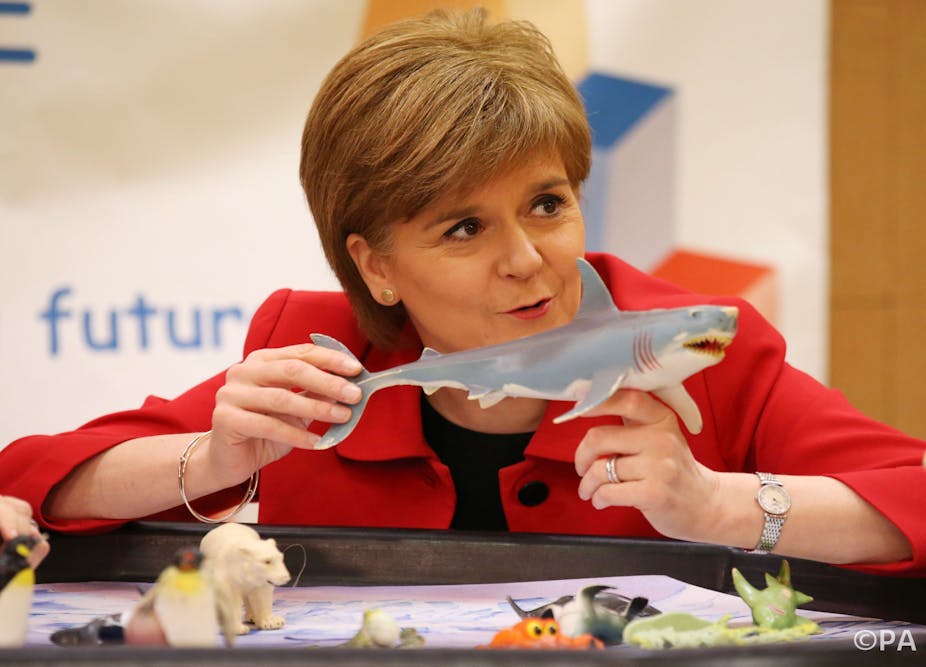On the day Theresa May took up residence at 10 Downing Street, the Scottish first minister Nicola Sturgeon had a message for her:
The incoming PM has said to her party that ‘Brexit means Brexit’ – but she must not forget that Scotland voted to stay in the EU, and so for us remain means remain.
It was an early reminder, in case the new British prime minister was in any doubt, that Scotland will be high in her in-tray. But what does May’s arrival mean for the Scottish independence movement? Will she have a different approach to David Cameron? Would it be different if another Tory leadership candidate had won?
Superficially, Sturgeon and May share common ground on Brexit. They both campaigned for Remain on June 23. Both emerged as sober, reassuring voices in the turmoil after Leave won narrowly at UK level but Remain won in Scotland (and in Northern Ireland, London and Gibraltar).
Both women command the respect, if not always the warmth, of their peers. They have strong reputations for being pragmatic and thoughtful on policy and political strategy as well as tough negotiators in their respective parliaments.
May vs Sturgeon will therefore be fascinating. Scotland’s Remain vote has of course put independence back on the table, less than two years after 55% of voters chose the union on a high turnout of 85%. Sturgeon long said a UK Leave/Scottish Remain vote would justify a second referendum, and she now thinks this “highly likely”.

The SNP’s problem is that they don’t want to push for another referendum until independence support is in the 60% bracket, still a few points higher than most recent polls. This necessitates a long game.
Meantime, Sturgeon is seeking a deal with EU leaders that would allow Scotland to remain in the EU while the rest of the UK leaves. She has also held meetings with London mayor Sadiq Khan and the chief minister of Gibraltar, Fabian Picardo with a view to building a strong alliance for future Brexit negotiations.
But should the EU effort fail, Westminster SNP leader Angus Robertson said recently that a second independence referendum would follow. Philip Hammond, May’s new chancellor, has since signalled that Sturgeon’s EU initiative is unlikely to be workable. A collision therefore looks very likely.
May well not
May mentioned the importance of the union in her maiden speech as prime minister, reminding her audience that she represents the Conservative and Unionist Party. She previously said she would “always stand up for Scotland’s place in the union”, and cited fears about Scotland as one reason for backing Remain.
She will keep a cooler head than defeated rivals Andrea Leadsom or Michael Gove. They are both volatile and outspoken and have displayed poor political judgement that would have haunted them over Scotland had either become prime minister.
Leadsom had previously complained about Scotland receiving too much taxpayers’ money, while Gove was accused of planning to scrap the Barnett formula that is used to distribute funds to UK regions according to need. May did add her voice to the Tory 2015 UK election message that voting Labour meant getting the SNP through a back-door coalition, but she still looks to have the least Scottish political baggage of the three.
May is probably also shrewd enough to be more careful than her blasé predecessor. She will want to learn from David Cameron’s promise to hold an EU referendum, which now looks a reckless gamble. This will likely make her reluctant to give the legal consent for a second Scottish referendum.
She will be acutely aware of the SNP’s 60% problem and will seek to keep separatist sentiment at bay through all means possible. Reminding the Scots of the power of the union looks like one strategy. We can also expect to hear her selling the value of being both in the UK and with favourable access to the European single market, assuming she achieves that kind of deal in the Brexit negotiations.
Relying on Ruth
Backed by only one Westminster MP in Scotland and with no mandate from a general election, however, May does lack legitimacy north of the border. Scottish Tory leader Ruth Davidson will therefore surely be a key lieutenant in selling the union, and has already been in London to confer with the new prime minister. As a popular politician with strong debating skills and a mischievous wit, she has brought the Tories back from the dead in Scotland to become the largest opposition party.
Davidson switched to supporting May for the leadership after Stephen Crabb pulled out, but will now have the chance to enhance her reputation north and south of the border. Her growing esteem in London is already clear from her recent appointment to the Privy Council.

Davidson did say prior to May’s arrival that the UK should not block another independence referendum (Scottish secretary David Mundell said similar). But that is not incompatible with a strategy to keep independence support below the level where the SNP would seek a vote.
The Scottish Tory leader has also urged May to seek “positive engagement” with the Scottish government, while saying a second independence referendum would be “irresponsible” and not “in the best interests of Scotland”.
For her part, Nicola Sturgeon will be watching those opinion polls closely and seeking to exploit all opportunities to make them shift. First up will probably be the Westminster vote on whether the UK should renew its Trident nuclear deterrent, based near Glasgow, to which the Scottish nationalists are passionately opposed. Expect them to make a case that May is out of touch with voters north of the border, and for this to be a running theme.
To be clear, it will be no small achievement if May manages to keep Scotland in the union in the coming years. But among the leadership hopefuls and compared to David Cameron, the Conservatives have almost certainly chosen the best person for the job.

